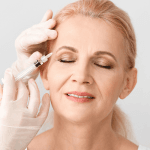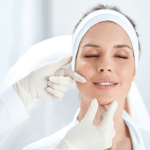Fine lines are among the earliest visible signs of aging, appearing subtly before progressing into deeper wrinkles. Studies show that skin collagen production begins to decline by about 1% each year after age 20, which gradually leads to loss of elasticity and the appearance of these fine creases. For aesthetic professionals and skin care practitioners, understanding how to get rid of fine lines is not only about surface correction but also about addressing the deeper structural changes in the skin that cause them.
Modern aesthetic medicine has evolved to provide comprehensive approaches, ranging from injectables and laser treatments to advanced skincare and microneedling, that help patients restore youthful radiance effectively and safely. This article explores professional-grade treatments, scientific mechanisms, and best practices to reduce fine lines and enhance skin texture for long-term results.
What Are Fine Lines?
Fine lines are shallow creases that form primarily on areas with frequent muscle movement, such as the forehead, around the mouth, and under the eyes. They are the earliest markers of skin aging and usually appear before deeper wrinkles develop.
These lines are mainly caused by:
- Loss of collagen and elastin fibers, resulting in reduced skin elasticity.
- Repeated facial expressions, including smiling or frowning.
- Environmental stressors, including UV exposure and pollution.
- Lifestyle factors, such as dehydration, smoking, and lack of sleep.
For professionals, early intervention at this stage is crucial, as fine lines respond better to preventive and regenerative treatments compared to mature wrinkles.
Common Areas Affected by Fine Lines
Fine lines can appear almost anywhere on the face, but certain areas are particularly vulnerable:
- Face – General textural irregularities often caused by aging and sun damage.
- Forehead – Typically linked to expressive movements and collagen breakdown.
- Under eyes – One of the most delicate areas, prone to thinning and dryness.
- Around the mouth – Also known as perioral lines, commonly caused by speaking, smiling, or smoking.
Understanding the anatomical differences in these areas allows clinicians to tailor treatments more effectively for natural, balanced results.
How to Get Rid of Fine Lines
The approach to eliminating fine lines requires a combination of in-office procedures and medical-grade skincare. The choice of treatment depends on the severity, skin type, and patient goals.
Botox for Fine Lines
Botulinum toxin injections remain one of the most effective treatments for dynamic fine lines, those caused by muscle activity. By temporarily relaxing facial muscles, Botox smooths out existing lines and prevents new ones from forming.
- Ideal for: Fine lines on the forehead, between the brows, and around the eyes.
- Treatment frequency: Every 3–6 months for optimal maintenance.
- Benefit: Provides a smooth, refreshed look without altering facial expression when administered by skilled injectors.
Microneedling for Fine Lines
Microneedling induces controlled micro-injuries that trigger collagen and elastin production. This natural healing response leads to improved skin firmness and reduced visibility of fine lines.
- Ideal for: Fine lines on face, under eyes, and around mouth.
- Combination therapy: Often paired with platelet-rich plasma (PRP) or peptides for enhanced collagen synthesis.
- Downtime: Minimal, with visible improvements over several weeks.
Dermal Filler for Lines
For static fine lines, those visible even when facial muscles are at rest, dermal fillers offer an immediate volume-restoring effect. Hyaluronic acid-based fillers integrate into the skin’s structure to plump and hydrate.
- Ideal for: Fine lines under the eyes and perioral areas.
- Results: Instant softening of lines, lasting from 6 to 12 months.
- Clinical tip: Use microcannulas and layered injection techniques for smoother integration.
Complementary Treatments for Optimal Results
A well-rounded rejuvenation plan doesn’t rely on one treatment alone. Clinics can combine multiple modalities to deliver long-lasting outcomes and enhance patient satisfaction.
Chemical Peels
These exfoliate the upper skin layers, promoting cell turnover and collagen renewal. Light peels can help refine texture and brightness while reducing superficial lines.
Laser Resurfacing
Fractional CO₂ or erbium lasers are ideal for addressing more pronounced fine lines and pigmentation, stimulating collagen remodeling deep within the dermis.
Medical-Grade Skincare
Products rich in retinoids, peptides, and antioxidants play an essential role in maintaining post-treatment results. Encourage patients to follow a tailored regimen that supports ongoing skin health.
Patient Education and Compliance
Long-term success in treating fine lines depends on patient education. Practitioners should emphasize:
- Sun protection – The number one factor in preventing premature aging.
- Consistent hydration – Both topical and internal hydration maintain skin elasticity.
- Healthy lifestyle – Encouraging balanced nutrition and reduced alcohol consumption supports better skin function.
- Follow-up treatments – Regular touch-ups help sustain the improvements achieved through initial procedures.
Educating patients about aftercare and routine maintenance builds trust and enhances clinical outcomes.
Addressing Specific Patient Concerns
Each patient’s experience with fine lines varies, and personalized care is key. Here’s how clinicians can address common aesthetic concerns:
Fine Lines Under Eyes
To effectively address fine lines under the eyes, consider using gentle treatments such as microneedling or low-viscosity dermal fillers. The delicate nature of the under-eye area’s thin skin requires a high level of precision and caution to avoid potential issues like puffiness or discoloration, ensuring a natural and youthful appearance.
Fine Lines on Forehead
When it comes to fine lines on the forehead, a well-planned combination of Botox and light dermal fillers can provide a smooth, rejuvenated look. This approach allows for the maintenance of natural expression lines, preserving the ability to convey genuine emotions while reducing the signs of aging.
Fine Lines Around Mouth
Fine lines around the mouth can be particularly challenging due to the frequent movement in this area. A thoughtfully designed blend of filler and collagen-stimulating treatments can offer optimal softening, effectively reducing the appearance of these lines while avoiding any stiffness, resulting in a more youthful and vibrant smile.
Integrating Regenerative Approaches
Aesthetic medicine is moving toward regenerative therapies that restore the skin’s natural capacity for renewal. Treatments like growth factors, exosome therapy, and collagen stimulators are gaining traction as long-term solutions.
For clinics, offering these advanced options differentiates services and positions your practice at the forefront of innovation. Combining traditional injectables with biostimulators helps prolong results and enhance skin quality over time.
Evaluating Treatment Results
Assessing progress after fine-line treatments involves more than surface observation. Clinicians should evaluate:
- Texture and smoothness – Measured through tactile feedback and photographic comparison.
- Hydration and elasticity – Improved moisture balance and suppleness.
- Even skin tone – Reduction of dullness and sun damage.
- Patient satisfaction – The ultimate measure of success in cosmetic procedures.
Regular follow-up appointments should be used to monitor improvements, document progress, and refine treatment plans as needed.
Safety and Ethical Considerations
While fine line treatments are generally safe, practitioners should maintain high standards of patient assessment, product sourcing, and technique. Always source products from reputable distributors and verify certifications to ensure authenticity and safety.
- Avoid overcorrection or “frozen” effects from excessive Botox use.
- Use hyaluronic acid fillers that are reversible with hyaluronidase for flexibility.
- Discuss potential risks such as bruising, swelling, or rare allergic reactions.
Professional ethics and patient transparency remain the cornerstone of responsible aesthetic practice.
Take Your Next Step
If your clinic is looking to expand its aesthetic treatment portfolio with clinically proven anti-aging solutions, consider partnering with a trusted medical supplier for premium-grade injectables and devices.
Partner with us today to bring your patients advanced, science-backed skincare — smoother, younger-looking results from professionals who care.
Takeaways
Understanding how to get rid of fine lines involves a combination of professional expertise, evidence-based treatments, and patient education. Aesthetic clinics should tailor each treatment plan to individual skin needs, ensuring both safety and satisfaction.
The rise of advanced injectables like Botox, microneedling, and dermal fillers highlights how innovation continues to refine non-surgical rejuvenation. Whether targeting fine lines under the eyes, on the forehead, or around the mouth, consistent care and high-quality products remain the foundation of long-term results.
Frequently Asked Questions (FAQs)
How do fine lines differ from wrinkles?
Fine lines are typically described as shallow, surface-level creases that appear on the skin, often as a result of normal aging and repetitive facial movements. In contrast, wrinkles are generally deeper folds that form when there is significant loss of collagen and elastin, essential proteins that help maintain the skin’s firmness and elasticity.
What is the best treatment for fine lines?
The most effective treatment approach for fine lines often involves a combination of options such as Botox, microneedling, and dermal fillers. These treatments can provide excellent results, but the best course of action depends on the individual patient’s age, skin condition, and personal preferences.
How often should patients undergo microneedling for fine lines?
Typically, microneedling sessions are spaced about 4 to 6 weeks apart to allow the skin adequate time to heal and rejuvenate. For ongoing skin maintenance and to achieve the best long-term results, many patients may benefit from maintenance treatments every 6 months.
Can lifestyle changes alone help reduce fine lines?
While healthy lifestyle habits such as balanced nutrition, proper hydration, adequate sleep, and sun protection certainly support overall skin health, relying solely on these changes may not be sufficient for significant improvement. Professional treatments, when combined with a diligent skincare routine, tend to yield faster and more visible results in reducing the appearance of fine lines.






